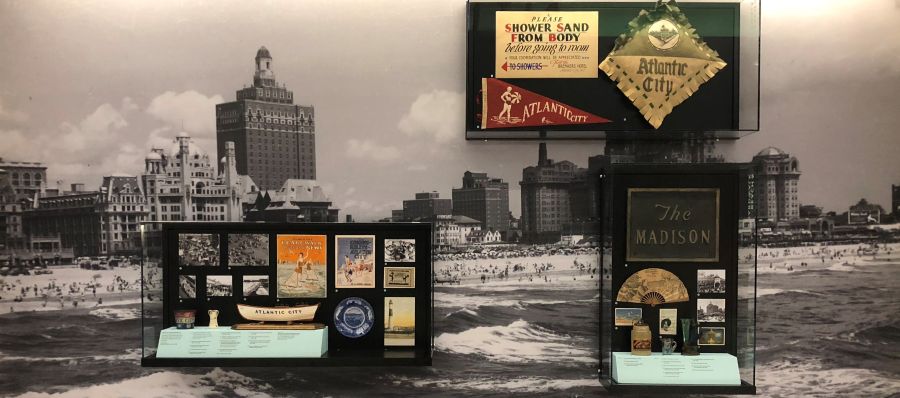The Beach and Boardwalk
A stroll on the Boardwalk and a day at the beach are hallmarks of a visit to Atlantic City, then and now.
Atlantic City was originally conceived of as a health resort. Visitors were encouraged to take the railroad from the congested cities to the seashore, breathe in the fresh air, and bathe in the salt water. Spending time at the beach was made safer with the Atlantic City Beach Patrol, on guard since 1892. Earlier bathers were watched by a constable of the police department.
As many of the early visitors did not own their own bathing suits, bath houses rented these and changing rooms. The earliest bathing suits worn in Atlantic City were full costumes - modesty and law dictated that the whole body be covered. For women, that meant wearing stockings until the 1920s; for men, shirts were required until at least 1940. Bathing suits, such as the ones on exhibit from the early 1930s, were often made of wool as the material repelled water and kept its shape better than cotton.
Overlooking the beach, the iconic Atlantic City Boardwalk was introduced as a way to keep sand from being tracked into the hotels’ lobbies. Several hoteliers and businessmen petitioned the city to construct a footwalk and the councilmembers approved $5,000. The walk - made of boards - opened to the public on June 26, 1870, and was eight feet wide, one mile long, and stood approximately one foot above the sand. This original boardwalk was removed and stored at the end of each year.
Later versions of the boardwalk were more permanent, with the last one constructed in 1896. It was designated as an official street in Atlantic City in 1895, and as a street name, Boardwalk is always capitalized when referring to the street in Atlantic City. The present-day Boardwalk is more than 4 miles long, 60 feet wide at its widest, and 12 feet above sea level at the highest point.
A walk along the wooden way or a ride in a rolling chair is a way to experience Atlantic City. The Absecon Lighthouse, first lit in 1857, while no longer right on the Boardwalk because of sand accretion, is the oldest structure in Atlantic City. The Boardwalk is lined with businesses and amusements and is the home to several piers. Atlantic City’s piers of the past and present are:
- West Jersey Pier (opened 1880, destroyed that same year)
- Howard’s Pier (opened in 1882, removed in 1889)
- Applegate’s Pier, later Young & McShea’s Pier, Young’s Ocean Pier, and now Central Pier (opened in 1884)
- Iron Pier, later Heinz Pier (opened in 1886 and closed in 1944)
- Steel Pier (1898 - present)
- Auditorium Pier, later Steeplechase Pier and now Margaritaville (opened in 1899)
- Young’s Million Dollar Pier, later Million Dollar Pier, Ocean One, The Pier Shops at Caesars and now The Playground (opened 1906)
- Garden Pier (1913 - present)
Where’s your beach?
Residents and visitors to Atlantic City frequently have a “favorite” spot on the sand. Whether it be convenience or comfort, people return year after year to a particular beach.
While Atlantic City’s beaches are free to all and open to anyone, in the first half of the twentieth century, this was not the case. In the 1920s, Boardwalk hotel owners complained to the City government that their guests did not want to share the beaches in front of their hotels with African American bathers. With Convention Hall under construction - and a large beach in front of it - the Missouri Avenue beach was designated as the segregated beach.
Designated Chicken Bone Beach by the locals, the name came from the practice of bringing picnics to the beach with fried chicken. This beach was a popular haunt of nationally-known figures, such as Sammy Davis, Jr., Martin Luther King, Jr., Billie Holliday, Sarah Vaughn, and others, often during their visits for concerts and conventions.
